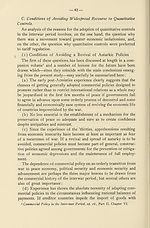Download files
Complete book:
Individual page:
Thumbnail gallery: Grid view | List view

43 —
which their debts can be paid, if new obligations are created and no
commodity provision made for their service, if debtor countries ob¬
struct the export of goods with which they may meet the service of
their debts, disequilibrium must be caused which will render wide¬
spread restrictions on imports inevitable.
(e) Again, to draw an arbitrary line between commercial policy
and other measures necessary for economic adjustment, as was fre¬
quently done especially in the ’twenties, is almost certain to produce
harmful results. Questions of commercial policy should be con¬
sidered by international bodies in conjunction with the whole catena
of post-war problems—relief and the manifold problems of recon¬
struction, as well as long-range questions such as the needs of coun¬
tries anxious to promote industrial development—that are likely to
arise.
(f) If wider free trade areas are desired, they ought to be created
immediately after the war before vested interests have time to de¬
velop ; and the possibility of establishing a derogation from the most¬
favoured-nation principle to permit the formation of preferential
unions under certain circumstances should be considered.
(g) Finally, the pursuit of uncoordinated programmes by great
States “is likely to involve a disruption of the whole mechanism of
trade and economic relations in general and must inevitably do so if
severe quantitative restrictions on trade are an integral part of such
programmes.” Planning for full employment and economic security
must be a major concern of the economic policy of the future; there
is little hope that international trade can be restored or that na¬
tional economic objectives can be achieved unless such planning is
coordinated and—in a large measure at least—worldwide.
(2) Conditions of Avoiding Recourse to Quantitative Controls.
(a) In both the periods we have been considering, the most clearly
discernible factor leading governments to introduce quantitative con¬
trols was currency instability accompanied by exchange dumping.
In the ’thirties, the situation was complicated and aggravated by the
protracted disequilibrium in national price levels resulting from the
unwillingness of important countries openly to adjust the value of
their currencies. Of no less importance, however—and itself a pri¬
mary cause of the currency instability—was the breakdown of the
which their debts can be paid, if new obligations are created and no
commodity provision made for their service, if debtor countries ob¬
struct the export of goods with which they may meet the service of
their debts, disequilibrium must be caused which will render wide¬
spread restrictions on imports inevitable.
(e) Again, to draw an arbitrary line between commercial policy
and other measures necessary for economic adjustment, as was fre¬
quently done especially in the ’twenties, is almost certain to produce
harmful results. Questions of commercial policy should be con¬
sidered by international bodies in conjunction with the whole catena
of post-war problems—relief and the manifold problems of recon¬
struction, as well as long-range questions such as the needs of coun¬
tries anxious to promote industrial development—that are likely to
arise.
(f) If wider free trade areas are desired, they ought to be created
immediately after the war before vested interests have time to de¬
velop ; and the possibility of establishing a derogation from the most¬
favoured-nation principle to permit the formation of preferential
unions under certain circumstances should be considered.
(g) Finally, the pursuit of uncoordinated programmes by great
States “is likely to involve a disruption of the whole mechanism of
trade and economic relations in general and must inevitably do so if
severe quantitative restrictions on trade are an integral part of such
programmes.” Planning for full employment and economic security
must be a major concern of the economic policy of the future; there
is little hope that international trade can be restored or that na¬
tional economic objectives can be achieved unless such planning is
coordinated and—in a large measure at least—worldwide.
(2) Conditions of Avoiding Recourse to Quantitative Controls.
(a) In both the periods we have been considering, the most clearly
discernible factor leading governments to introduce quantitative con¬
trols was currency instability accompanied by exchange dumping.
In the ’thirties, the situation was complicated and aggravated by the
protracted disequilibrium in national price levels resulting from the
unwillingness of important countries openly to adjust the value of
their currencies. Of no less importance, however—and itself a pri¬
mary cause of the currency instability—was the breakdown of the
Set display mode to:
![]() Universal Viewer |
Universal Viewer | ![]() Mirador |
Large image | Transcription
Mirador |
Large image | Transcription
Images and transcriptions on this page, including medium image downloads, may be used under the Creative Commons Attribution 4.0 International Licence unless otherwise stated. ![]()
| League of Nations > Economic and financial section > Quantitative trade controls > (45) |
|---|
| Permanent URL | https://digital.nls.uk/190588578 |
|---|
| Shelfmark | LN.II |
|---|
| Description | Over 1,200 documents from the non-political organs of the League of Nations that dealt with health, disarmament, economic and financial matters for the duration of the League (1919-1945). Also online are statistical bulletins, essential facts, and an overview of the League by the first Secretary General, Sir Eric Drummond. These items are part of the Official Publications collection at the National Library of Scotland. |
|---|---|
| Additional NLS resources: |
|

